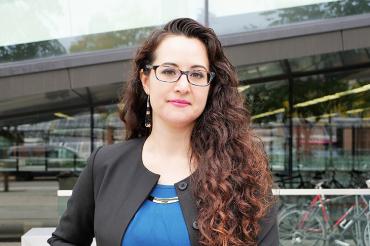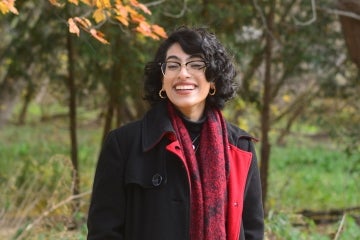‘Not just part of the past’: U of T’s Jennifer Brant on teaching the subject of residential schools in Canada

(Photo by Marianne Lau)
Published: July 6, 2021
For many Canadians, the recent discovery of remains of 215 children at a former residential school in British Columbia – followed by the discovery of 751 unmarked graves at the site of the former Marieval Indian Residential School in Saskatchewan and still others at a residential school near Cranbrook, B.C. – hammered home the brutality and violence inflicted on Indigenous Peoples in Canada.
Yet, for Indigenous Peoples themselves, the trauma inflicted by the residential school system is nothing new – it has been lived and passed on through generations. What’s more, the Truth and Reconciliation Commission of Canada painstakingly detailed the scope and severity of residential schools, which forcibly separated Indigenous children and youth from their communities for at least 165 years. The last residential school closed in 1996.
Jennifer Brant, an assistant professor in the department of curriculum, teaching and learning at the University of Toronto’s Ontario Institute for Studies in Education (OISE), says one reason for many Canadians’ seeming inability to fully understand the horrific legacy of residential schools is the way the subject has traditionally been taught in school – if it has been taught at all.
“The language is still very much toned down in the latest textbooks,” says Brant, a member of the Kanien’kehá:ka (Mohawk) Nation with family ties to Six Nations of the Grand River Territory and Tyendinaga Mohawk Territory who teaches courses on Indigenous literatures, structural and colonial violence and Indigenous maternal pedagogies.
“Residential schools are referred to as a ‘process of assimilation,’ when, in reality, they intended to ‘kill the Indian in the child.’ This wasn’t just an assimilation project – this was a project of genocide.”
See Brant and U of T’s Eve Tuck analyze an Indigenous textbook chapter for the Toronto Star
By contrast, when Brant discusses residential schools in her classroom, she begins with the story of her grandmother, who was forced to attend the Mohawk Institute in Brantford, Ont., a place otherwise known as the “mush hole.” It was run by the Anglican Church and has now become the Woodland Cultural Centre. As in other residential schools, children’s names were replaced by numbers.
“I’m told that my grandmother was referred to as number 67,” Brant says. “She was not provided an education that included the traditional subjects we know today such as math and science. Rather, she learned to sew, clean and polish silver and spend most of her days in the laundry room.
“Children were threatened and told their cultural ways were ‘savage’ and of the ‘devil’. They were trained to be god-fearing and domestic.”
The search for unmarked graves at the former Mohawk Institute is set to begin in the coming weeks.
Brant recently spoke to U of T News about the need for curriculum updates, a new language to discuss residential schools, effective responses to the Truth and Reconciliation Commission’s Calls to Action and a deeper understanding of the ongoing trauma inflicted upon Indigenous Peoples in Canada.
What’s your approach to facilitating discussions of difficult subjects such as residential schools in your classroom?
Indigenous maternal pedagogies are a big part of my teaching philosophy. I try to establish and foster an ethical and culturally safe classroom environment, especially because some of the conversations that arise can lead to contentious dialogue and resistances in the classroom. These discussions need to be approached with care and I am always concerned of the students in my class who have experienced the intergenerational effects of residential schools in their own families. Not only is this part of my teaching philosophy but it is foundational to my SSHRC (Social Sciences and Humanities Research Council) study that looks at Indigenous experiences in teacher education. From the very first day of class, I establish an environment of ethical dialogue between all learners as we engage in cross-cultural and anti-racist dialogue.
Moreover, I draw from – and extend on – Indigenous ways of contextualizing knowledge. At times, this means engaging students in learning circle discussions and centring Indigenous stories and literatures. I position the classroom as a learning environment that fosters knowledge transfer. We are all learning from each other, and I, myself, am also a learner in that engagement.
I also encourage students to engage in meaningful reflection throughout my courses. As an example, at the start of the course, students are asked to write an initial reflection that documents where they are right now in their learning journey as it relates to Truth and Reconciliation. Similar reflective assignments throughout the course prompt them to reflect on their growth and their intentions to continue learning. I find this a humbling process that engages students to continue learning about what truth and reconciliation means to them beyond the course. This is especially important in teacher education courses. As (TRC chair and former) Justice Murray Sinclair articulated, “education is the key to reconciliation.”
How do you explain the residential school system to students?
While many students – and Canadians at large – have heard about residential schools, they don’t understand the extent of what actually occurred. The language is still very much toned down in the latest textbooks. Residential schools are referred to as a “process of assimilation,” when, in reality, they intended to “kill the Indian in the child.” This wasn’t just an assimilation project – this was a project of genocide.
I use a variety of resources to help students understand the extend of what took place in residential schools. Students will watch Where the Spirit Lives, a 1989 film, and read young adult books such as Sweetgrass Basket by Marleen Carvell or Indian Horse by Richard Wagamese.
The intention of school is for students to learn and contribute what they have learned to society in one way or another. But residential school survivors like my late grandmother did not learn skills that would prepare her for a career outside the home. They were doing laborious work: scrubbing floors, spending their days in the laundry room and being trained in domesticity. Rather than being offered an education, they were indoctrinated in the colonial, gender-binary and enforced, oppressive-gendered notions of the body. Students were taught to fear their bodies. As an example, there are stories of girls being told that they were being punished when they received their first period – that they were bleeding out as a form of punishment from God. There are countless stories of the physical, sexual and spiritual abuses that took place in residential schools.
These institutions weren’t really schools. Schools don’t have cemeteries. Schools don’t conduct nutrition experiments on students by starving them and feeding them rotten food. Children don’t go to school to be taught that they don’t have souls. Perhaps we need a new language, a new term, to articulate what these places really were. That’s an important part of the conversation.
What do these recent discoveries mean for truth and reconciliation in Canada?
It has been six years since the closing ceremonies of the Truth and Reconciliation Commission of Canada. That is six years since the 94 Calls to Action were released. It’s very problematic that the 94 Calls to Action have not been completed, implemented or satisfied. According to a 2020 accountability report from the Yellowhead Institute, just eight of the calls to action have been implemented, which is actually down from nine in 2019. Following the TRC, there was some momentum, similar to what we’re seeing now, but, in some ways, it has become very superficial. Commitments to reconciliatory education were expressed, land acknowledgements have become a common practice, there have been apologies, but these are all without meaningful action behind them. Now is the time for action.
I find that a lot of my students express feeling unprepared to teach about residential schools when they enter my course, and this is a common concern across Canada. Teachers need access to updated history textbooks, they need support for bringing in Indigenous resources and they need mandatory professional development. As I articulated in the Yellowhead accountability report: “We also need a structured and effective network that seamlessly connects education for reconciliation in teacher education programs, with ministries of education and school boards. This connection is missing.”
This moment of reckoning in Canada means that teachers can no longer use the excuse that they don’t know.
What is the best way for Canadians to learn more about the residential school system?
The information that is coming out about residential schools should not be new to Canadians. The TRC report had an entire section on unmarked graves. This was released over six years ago. Reclaiming Power and Place, the final report of the National Inquiry into Missing and Murdered Indigenous Women and Girls was released two years ago with 231 individual “Calls for Justice” to immediate action and specific calls for education. All Canadians need to read the reports and the associated Calls to Action and Calls to Justice.
There are a significant number of calls that are dedicated to education. The literature and resources to respond to these calls are readily available. There are age-appropriate children’s books and young adult novels to effectively integrate residential school curricula from K-12.
One book in particular that I always have my students read – and believe all Canadians need to read – is Tanya Talaga’s Seven Fallen Feathers. Her book documents the stories of seven Indigenous youth who left their communities between the years 2000 and 2011 to attend high school in Thunder Bay, Ont., and later went missing. Thunder Bay is a northern city characterized by a history of colonial violence against Indigenous Peoples. According to a Thunder Bay Police Services Board investigation, “[T]he Indigenous population of Thunder Bay experiences racism, both overt and systemic, on a daily basis. High-profile cases of murder and violence are only the tip of the iceberg.” The death of these youth who left their home communities to attend school should be a wake-up call for Canada, and serves as a striking example of the way this genocide is ongoing.
In what ways is the residential school system continuing to inflict harm on Indigenous communities today?
All this history is really not just history – it’s still happening today, in different ways. While there is a lot of talk about how these schools were run by the Catholic Church, many were run by Anglican and other churches as well, but it is also really important to note that this was a system administered by the government of Canada. Sir John A. Macdonald and Egerton Ryerson are both known as the architects of the residential school system. Unfortunately, these individuals continue to be honoured for their roles in the development of Canada and its education system.
As Chief Cadmus Delorme of Cowesses First Nation put it: “The world is watching as we unearth genocide here in Canada.” But while this is happening, Canada is still fighting the survivors of the St. Anne’s residential schools in court and refusing to release residential school documents. The government is still fighting the ruling by the Canadian Human Rights Tribunal over its discrimination of Indigenous children. It’s important for Canadians to understand that this is not just part of the past. As we’re learning about these unmarked graves, the government is still in court right now fighting Indigenous children.
Residential school survivors or those impacted by residential schools can access support through the Indian Residential Schools Crisis Line at 1-866-925-4419. It is available 24 hours a day for anyone experiencing pain or distress as a result of their residential school experience.
Resources available to the U of T community:
U of T students can access supports through the university’s Indigenous Student Services while U of T My Student Support Program (SSP) offers students 24-hour confidential support that can be accessed over the phone in 35 languages, while support scheduled in advance is available in 146 languages.
Staff and faculty can access the Employee and Family Assistance Program which offers confidential short-term counselling and support for issues relating to mental health, health management and workplace well-being. To access EFAP services, please contact Homewood Health at 1-800-663-1142.
U of T’s Office of Indigenous Initiatives is available to connect Indigenous students, staff, faculty, librarians, and community members across U of T.
Beyond U of T, the following resources are also available to members of the Indigenous community:
- Toronto Aboriginal Support Services Council (TASSC)
- 2 Spirited People of the 1st Nations
- Anduhyaun Inc.
- Native Child & Family Services of Toronto
- Native Women’s Resource Centre of Toronto
- Toronto Council Fire Native Cultural Centre
- Dodem Kanonhsa’
- Native Canadian Centre Toronto
- Ontario Federation of Indigenous Friendship Centres
- Na-Me-Res (Native Men’s Residences)
- Anishinawbe Health Toronto



